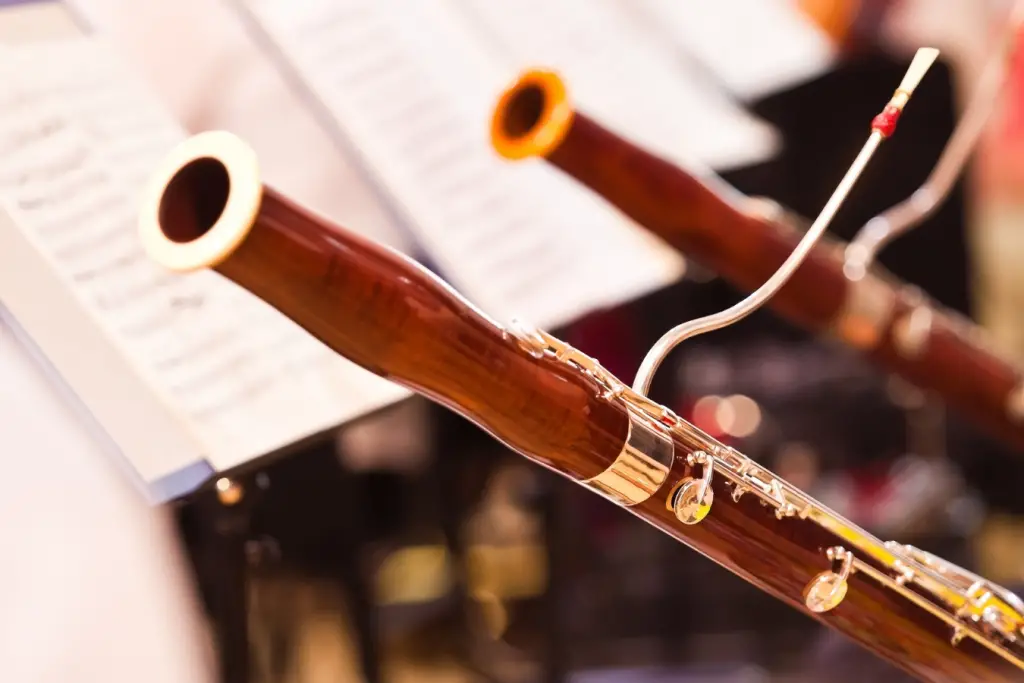The bassoon and contrabassoon are integral members of the woodwind family, known for their rich, resonant tones and ability to bring depth to orchestral and chamber music. While they share many similarities, they also have distinct differences that set them apart. This article explores the key characteristics of each instrument, their unique roles in music, and how they compare in terms of size, sound, and usage.
Overview of the Bassoon
1. What Is a Bassoon?
- The bassoon is a double-reed woodwind instrument with a distinctive folded shape.
- Known for its warm and expressive tone, it can cover a wide range of pitches and styles.
2. Key Features
- Range: Typically spans from B♭1 to E5, making it a versatile instrument for both melody and harmony.
- Construction: Made of maple wood or plastic, with over 20 keys for precise pitch control.
- Weight: Weighs around 6–8 pounds, making it lighter than its larger counterpart.
3. Role in Music
- The bassoon is often used for its ability to blend with other instruments, provide counterpoint melodies, or add a comedic touch with its unique timbre.
- Common in orchestras, chamber ensembles, and even solo performances.
Overview of the Contrabassoon
1. What Is a Contrabassoon?
- The contrabassoon is the larger, deeper-voiced relative of the bassoon.
- It is sometimes referred to as the double bassoon due to its ability to play an octave lower than the standard bassoon.
2. Key Features
- Range: Extends from B♭0 to B♭3, making it one of the lowest-pitched instruments in the orchestra.
- Construction: Significantly larger, with a longer bore folded multiple times to accommodate its size.
- Weight: Can weigh up to 15 pounds, requiring additional support for players.
3. Role in Music
- The contrabassoon adds depth and weight to the lower register, often doubling the bass line in orchestral works.
- Its distinctive growling tone is used for dramatic effects or to enhance the foundation of an ensemble.
Size and Construction
1. Bassoon
- Measures approximately 4 to 5 feet (1.2 to 1.5 meters) when fully assembled.
- Compact design with a curved bocal (metal tube) for connecting the reed.
2. Contrabassoon
- Nearly twice the size of the bassoon, reaching up to 10 feet (3 meters) in length when unfolded.
- The bore is folded multiple times to make the instrument manageable.
- Requires a floor peg or stand to support its weight during performances.
Sound and Range
1. Bassoon’s Tone
- Warm, expressive, and versatile.
- Excels in melodic passages, harmonies, and humorous effects.
- Can achieve a wide dynamic range, from soft and mellow to loud and assertive.
2. Contrabassoon’s Tone
- Deep, resonant, and powerful.
- Provides a rumbling bass foundation in orchestral and ensemble settings.
- Limited agility compared to the bassoon, making it less suitable for intricate melodies.
Key Differences
1. Pitch
- Bassoon: Plays in a higher register, with a range that covers both tenor and bass roles.
- Contrabassoon: Plays an octave lower than the bassoon, focusing exclusively on the bass register.
2. Weight and Size
- The contrabassoon is significantly larger and heavier, requiring additional support mechanisms such as a floor peg.
3. Ease of Play
- The bassoon is generally more agile, making it suitable for quick passages and solos.
- The contrabassoon’s size and deeper pitch limit its speed and versatility but give it unmatched richness in the lower register.
Roles in an Orchestra
1. Bassoon
- Often plays supporting harmonies, counter-melodies, or prominent solos.
- Frequently used in classical and contemporary orchestral repertoire.
- Notable for its ability to bridge the gap between woodwinds and strings.
2. Contrabassoon
- Primarily reinforces the bass line, often doubling the double bass or tuba.
- Creates dramatic effects in moments requiring a thunderous low end.
- Used sparingly in orchestral works but adds significant impact when included.
Notable Repertoire
1. Bassoon
- Concertos: Mozart’s Bassoon Concerto in B♭ Major, Weber’s Bassoon Concerto in F Major.
- Orchestral Works: Prokofiev’s Peter and the Wolf, Stravinsky’s The Rite of Spring.
2. Contrabassoon
- Symphonies: Mahler’s symphonies, where it adds depth and intensity.
- Film Scores: Often used in dramatic soundtracks to create a sense of gravity or foreboding.
Practical Considerations
1. Cost
- Bassoon: A high-quality bassoon ranges from $6,000 to $40,000, depending on the model and craftsmanship.
- Contrabassoon: Generally more expensive, with prices starting at $20,000 and exceeding $50,000 for professional models.
2. Portability
- The bassoon is easier to transport due to its smaller size and weight.
- The contrabassoon requires a larger case and careful handling due to its bulk.
3. Playing Accessories
- Both instruments use similar reeds, though the contrabassoon reed is larger.
- Supports like seat straps, harnesses, or floor pegs are essential for comfortable playing.
Which Instrument Is Right for You?
1. Consider the Music You Want to Play
- If you prefer a versatile instrument capable of handling melodies and harmonies, the bassoon is ideal.
- If you’re drawn to the deep, foundational tones of the orchestra, the contrabassoon is a better fit.
2. Physical Considerations
- The bassoon is more manageable for younger or smaller players.
- The contrabassoon requires greater physical strength and endurance.
3. Budget and Availability
- The bassoon is more widely available and has a broader range of beginner models.
- The contrabassoon is a specialized instrument, often limited to advanced players or professionals.
Conclusion
The bassoon and contrabassoon each offer unique contributions to the world of music. While the bassoon is versatile and expressive, capable of handling a wide range of roles, the contrabassoon provides unmatched depth and resonance in the lower register. Understanding their differences in size, weight, tone, and roles in ensembles can help musicians choose the instrument that best suits their interests and capabilities. Both instruments are indispensable in creating the rich tapestry of sounds that define orchestral and chamber music.

